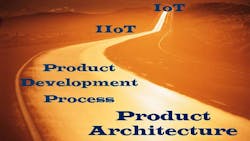Sensors Are Essential To Be IIoT- and IoT-Competitive
This file type includes high resolution graphics and schematics when applicable.
It has become clear to many this past year that the predictions of the speed at which the Industrial Internet of Things (IIoT) and Internet of Things (IoT) will develop will prove truer than not in the decade ahead. Hmmm. Ten years. 2026. If your company’s time-to-market for new products is two to three years, then it has somewhere between three and five development cycles to assure that it does not fall behind.
In this column, we look at a narrow slice of one part of the IIoT and IoT challenge. Big Data, neural networks, smart machines, and artificial intelligence all require “source data.” In short, a great amount of the IoT discussion comes down to sensors.
Sensors of all types and sizes will be needed to generate the source data upon which the IoT’s intelligence will largely be built. Companies that make the most progress in the next 10 years in embedding and augmenting their hardware and electronics with data gathering and generating capabilities will likely be the market leaders in the following decade.
There are three primary ways to “sensorize” products. Companies can surround their products with third-party sensing capabilities, an adjacent appended approach. Companies can retrofit products through value engineering and sustaining activities, a partially integrated approach. Or, companies can modify their product architecture today so that all new products will be “IIoT-ready” at launch, a fully integrated approach. IIoT-ready doesn’t mean fully sensored-up. It means that what is available today is already on-board and the product design facilitates the addition of new capabilities as they come down the pike.
Companies should take inventory of all the current and future sensors likely to exist. What exists today is perhaps a tenth of what is coming. A robust literature search will do the job to establish an inventory. For example, MEMS technology is here (and shrinking rapidly) and new “printed sensors” will soon be commercially available. Printed sensors take up almost no room, but still need designs that provide for them. Then examine the architecture(s) of company product lines and develop a systematic blueprint or roadmap of how product designs should change to incorporate sensors. Unless companies get in front of this, they will experience a slew of engineering change orders starting in a few years as customers force companies to “sensorize” their products. The room to skate around that issue exists today, but will soon be gone.
To make the point, Global Purchasing, Machine Design’s sister website, published IHS data showing that the average sensor density in biometric devices will rise from 1.4 to 4.1 sensors per product by 2019. Of course, this extrapolates across products and industries. The train is on the tracks. We should already be systematically architecting all new products for the IoT, and the same for retrofitting. Examining both challenges together will likely make it easier and less expensive in terms of product and development costs.
Let’s now assume companies have developed “sensor-enabled product architectures.” Doesn’t this have tremendous implications for the product development process? At the beginning of the process, during definition, not only will “portfolio-fit” and “roadmap-fit” checks be necessary but also an “IoT-fit.” At project approval, every plan will need “sensor modules” that manifest in project Gantt charts and may even change the way bills of materials are structured. Throughout the design process, just about every design and quality review will need additional checklist items. Test suites will have to be overhauled, and they will become greatly expanded. Beta testing with customers will yield new surprises. At launch, the marketplace will comment not only on the product but also on its readiness for the IoT. There is much work to be done to “IoT-ize” the product development process.
The architectural relationships between the manufacturing-process sensors, the product being manufactured, and how data gets from the product’s sensors into the network are major subjects for another day.
Three to five product cycles is not a lot of time. Will your company’s products be IIoT- and IoT-ready, or will it be retrofitting in 2026?
This file type includes high resolution graphics and schematics when applicable.
About the Author
Bradford Goldense
Contributing Technical Expert
Bradford L. Goldense is founder and president of Goldense Group, Inc. [GGI] (www.goldensegroupinc.com), a consulting, market research, and education firm focused on business and technology management strategies and practices for product creation, development, and commercialization. He has been an adjunct faculty member of the graduate engineering school at Tufts University's Gordon Institute for 19 years. Goldense is a Certified New Product Development Professional [NPDP], a Certified Manufacturing Engineer [CMfgE], a Certified Computer Professional [CCP], and is Certified In Production & Inventory Management [CPIM]. He holds over 200 registered copyrights and is a recognized subject-matter expert, including appearances on PBS and CNBC. He has consulted to over 250 companies and over 750 manufacturing locations on four continents since founding GGI in 1986. Goldense holds an MBA in Accounting from the Cornell Johnson School and a BSCE from Brown University. For more information, please see Brad's LinkedIn profile or visit GGI's home page.



